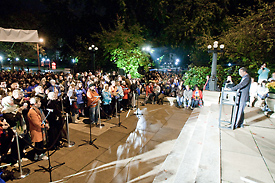Related stories:
Peace Corps student symposium
focuses on international service >
U-M students, alumni, faculty and staff huddled close outside the Michigan Union in a cold rain well past 2:30 a.m. Oct. 14. And a crowd gathered eight hours later to reflect on how John F. Kennedy’s idea, articulated 50 years earlier, continues to shape the university and world.
Those assembled in sessions throughout the week frequently discussed the ways Kennedy’s brief impromptu remarks, made a half century ago, fueled a belief that they can make a difference and “change the world.” Many noticed the similarities between the 1960 gathering of more than 5,000 and this year’s gathering at and near the same spot.
Kennedy’s 2 a.m. Oct. 14, 1960, challenge — where he asked students about “your willingness to contribute part of your life to this county,” and the enthusiastic response of the U-M community — widely is credited with giving birth to the Peace Corps and a universitywide dedication to public service through numerous other organizations.
President Mary Sue Coleman and Corps Director Aaron Williams signed an agreement to take that 50-year-old relationship a step further through a new partnership pairing graduate studies in social work, natural resources and the environment, landscape architecture, and a master’s in education with Peace Corps volunteer service.
The program will allow selected students the opportunity to earn U-M credit hours for their Peace Corps service through the Master’s International program.

Peace Corps Director Aaron Williams welcomes a large crowd that gathered at 2 a.m. Oct. 14 on the steps of the Michigan Union to celebrate the 50th anniversary of the the Peace Corps. On the same day in 1960, John F. Kennedy gave a speech challenging students to dedicate themselves to international service. Photo by Scott Galvin, U-M Photo Services.
“You ignited the spark that electrified America. This is your time. Join us in this crusade,” Williams told a crowd of more than 1,500 that gathered at 2 a.m. Thursday to mark the exact hour of Kennedy’s speech.
Coleman, speaking at a similar 11 a.m. gathering outside the Union, recalled being a 17-year-old high school senior in 1961, when she met Kennedy and visited the White House as a finalist in the nationwide Westinghouse Science Talent Search competition.
“I can’t tell you how exciting this was to a 17-year-old, to meet and speak with President Kennedy,” Coleman recalled. “The memory is so strong for me because it was just days after the president had signed the executive order creating the Peace Corps.
“I thanked President Kennedy for making the Peace Corps a reality, and for believing that our generation would help change the world. I could not have imagined that one day I would have the privilege to literally stand at the birthplace of the Peace Corps and thank the students and faculty whose enthusiasm made JFK’s vision such a powerful reality.”
At the 2 a.m. ceremony, Alan Guskin, who 50 years earlier was a U-M student activist moved to advocate for the creation of the Peace Corps after hearing Kennedy speak, told the crowd he still is amazed a group of U-M students influenced a new president to form an organization that has changed the way Americans serve the world.
“As Margaret Mead said, never doubt that a small group of thoughtful, committed people can change the world. Indeed, it is the only thing that ever has,” Guskin said.
Steven Weinberg, a U-M student and founder of Will Work for Food, a group that raises donations for charitable work and then uses the donations to pay for food for undernourished children, told the early morning crowd his organization is just one of the dozens created by U-M students endeavoring to improve the world in which they live one neighbor at a time.
Weinberg credited the events associated with Kennedy’s visit to the steps 50 years ago with helping to engender a culture of service at the U-M that lives on and thrives.
At the 11 a.m. event, Jack Hood Vaughn, a 91-year-old U-M alumnus and the second director of the Peace Corps (from 1966-69), said, “A person is known for where his heart is rather for where his home is, and my heart is here.” He said U-M changed his life and he wouldn’t have gotten the attention of Peace Corps founder Sargent Shriver if he hadn’t coached boxing at U-M and gone on to fight boxing legend Sugar Ray Robinson.
Vaughn said Peace Corps volunteers and U-M students are the kinds of committed people “who don’t just go the distance. They stay.”
He said the Peace Corps “made the concept of the ugly American obsolete.”

